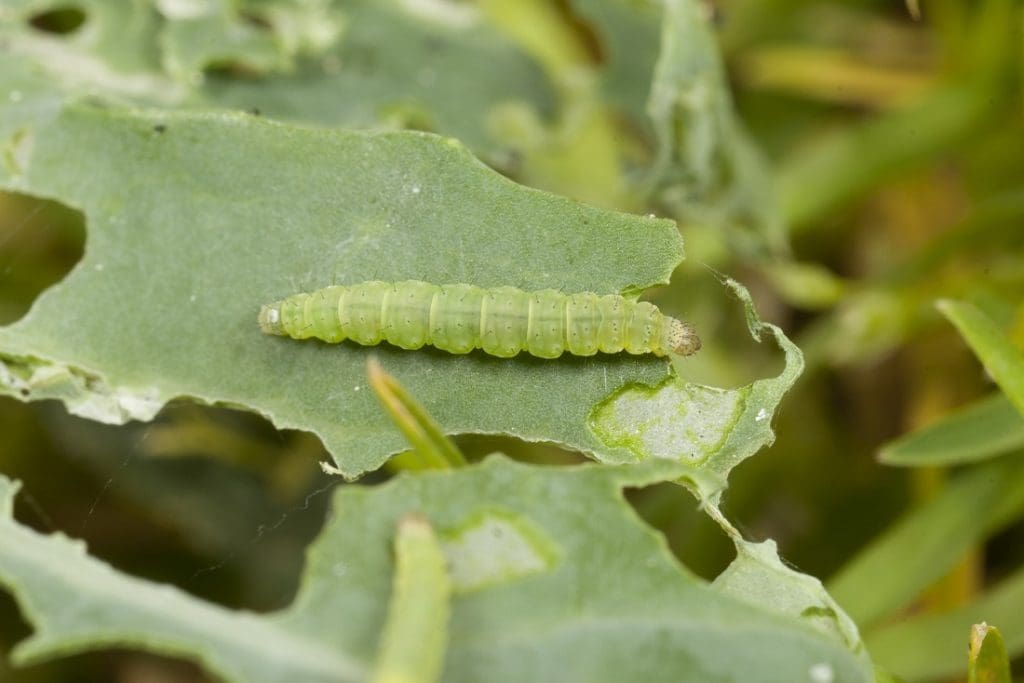
Diamondback moth has the ability to reproduce very quickly in warm spring temperatures and therefore explosive outbreaks of this pest can occur in some years. Photo: DPIRD
NEW research aims to provide Western Australian canola growers with earlier warning about potential diamondback moth (DBM) outbreaks so they can be more pro-active in managing the insect pest.
Grains Research and Development Corporation (GRDC) Crop Protection Manager – West, Georgia Megirian, said DBM was arguably the most damaging pest of WA canola crops, partly due to its population dynamics and ability to reduce crop yields significantly in a short period of time.
“In years in which DBM is a problem, it can affect about a third of the State’s canola crop and significantly reduce grain yields if left uncontrolled,” Ms Megirian said.
“DBM has the ability to reproduce very quickly in warm spring temperatures and therefore explosive outbreaks of this pest can occur in some years.
“Canola growers are currently forced to monitor crops regularly in spring, including sweep netting, to gauge numbers of DBM caterpillars.
“The evolution of resistance to insecticides in DBM means growers have limited insecticide options, and canola crops can be difficult to penetrate with insecticidal sprays. Managing DBM populations so that they remain below economic thresholds is an increasing and substantial challenge.”
The research that has commenced this year has co-investment from the GRDC, the Department of Primary Industries and Regional Development (DPIRD) and the South Australian Research and Development Institute (SARDI).
DPIRD entomologist and lead researcher, Dustin Severtson, said it would reveal more information about how plants, such as species from the Brassica family, were harbouring DBM in summer and winter.
“The project will address a key research gap in DBM ecology and management by finding out where in the landscape these host plants are occurring, and how DBM subsequently move through the grainbelt and re-colonise canola crops,” he said.
“New knowledge about the population dynamics of DBM would help to prevent DBM outbreaks by enabling us to control their plant hosts and manage the pest earlier in the year.
“Information could also be used to produce a forecasting system for DBM, similar to those already developed for crop diseases such as blackleg disease in canola and black spot disease in field pea.
“Overall, the key aim of this project is to increase the preparedness of growers and advisers in WA to implement timely, integrated DBM management strategies that will also help delay the further development of insecticide resistance.”
Dr Severtson said strategic surveillance of potential DBM plant hosts would be conducted in WA’s five port zones – in areas including roadsides, paddocks and coastal vegetation – and initial work had already been carried out early in 2019.
“In addition, the project will include DBM resistance testing and molecular identification of the two DBM species, Plutella xylostella and Plutella australiana,” he said.
“Monitoring canola crops that are nearby to any identified plant hosts will confirm whether DBM infestation in canola crops is caused by this ‘green bridge’, and whether it should be considered as a cause of DBM outbreaks.”
Dr Severtson said research by GRDC-supported University of Adelaide PhD student and South Australian Research and Development Institute (SARDI) entomologist Kym Perry had already determined that dune-dwelling plants such as Lincoln weed were significant refuges for DBM in South Australian canola growing areas.
Source: GRDC
More information:
GRDC Diamondback Moth Fact Sheet at www.grdc.com.au/GRDC-FS-DBM or on the DPIRD website at http://bit.ly/2x5sRu5.
GRDC Resistance management strategy for diamondback moth in Australian canola available at http://bit.ly/31F9xkl and the SARDI PestFacts article Keep an eye on diamondback moth at http://bit.ly/2NI7icv.

Has there been any work done on finding a predator for DBM. ??